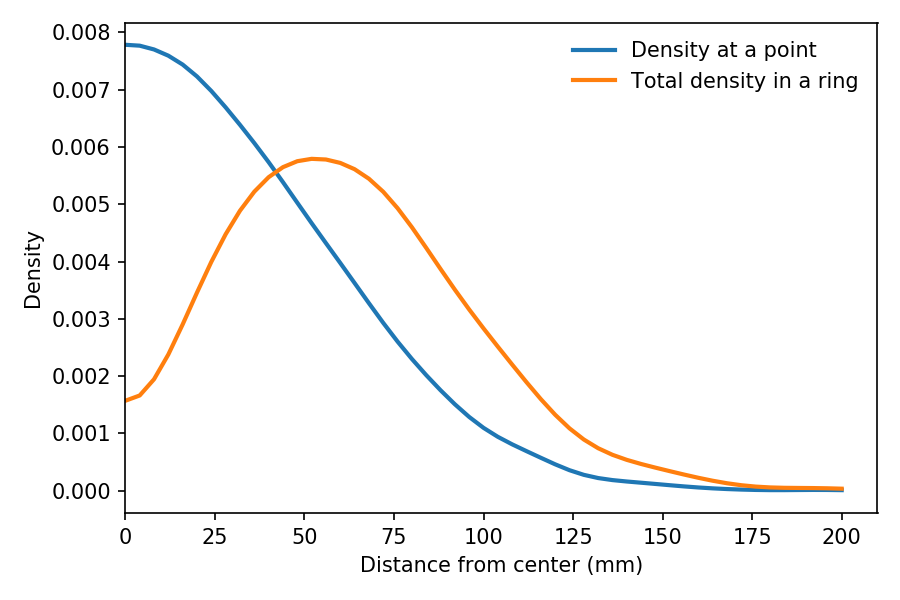The Dartboard Paradox
On November 5, 2019, I will be at PyData NYC to give a talk called The Inspection Paradox is Everywhere [UPDATE: The video from the talk is here]. Here’s the abstract:
The inspection paradox is a statistical illusion you’ve probably never heard of. It’s a common source of confusion, an occasional cause of error, and an opportunity for clever experimental design. And once you know about it, you see it everywhere.
The examples in the talk include social networks, transportation, education, incarceration, and more. And now I am happy to report that I’ve stumbled on yet another example, courtesy of John D. Cook.
In a blog post from 2011, John wrote about the following counter-intuitive truth:
For a multivariate normal distribution in high dimensions, nearly all the probability mass is concentrated in a thin shell some distance away from the origin.
John does a nice job of explaining this result, so you should read his article, too. But I’ll try to explain it another way, using a dartboard.
If you are not familiar with the layout of a “clock” dartboard, it looks like this:

I got the measurements of the board from the British Darts Organization rules, and drew the following figure with dimensions in mm:

Now, suppose I throw 100 darts at the board, aiming for the center each time, and plot the location of each dart. It might look like this:

Suppose we analyze the results and conclude that my errors in the x and y directions are independent and distributed normally with mean 0 and standard deviation 50 mm.
Assuming that model is correct, then, which do you think is more likely on my next throw, hitting the 25 ring (the innermost red circle), or the triple ring (the middlest red circle)?
It might be tempting to say that the 25 ring is more likely, because the probability density is highest at the center of the board and lower at the triple ring.
We can see that by generating a large sample, generating a 2-D kernel density estimate (KDE), and plotting the result as a contour.

In the contour plot, darker color indicates higher probability density. So it sure looks like the inner ring is more likely than the outer rings.
But that’s not right, because we have not taken into account the area of the rings. The total probability mass in each ring is the product of density and area (or more precisely, the density integrated over the area).
The 25 ring is more dense, but smaller; the triple ring is less dense, but bigger. So which one wins?
In this example, I cooked the numbers so the triple ring wins: the chance of hitting triple ring is about 6%; the chance of hitting the double ring is about 4%.
If I were a better dart player, my standard deviation would be smaller and the 25 ring would be more likely. And if I were even worse, the double ring (the outermost red ring) might be the most likely.
Inspection Paradox?
It might not be obvious that this is an example of the inspection paradox, but you can think of it that way. The defining characteristic of the inspection paradox is length-biased sampling, which means that each member of a population is sampled in proportion to its size, duration, or similar quantity.
In the dartboard example, as we move away from the center, the area of each ring increases in proportion to its radius (at least approximately). So the probability mass of a ring at radius r is proportional to the density at r, weighted by r.
We can see the effect of this weighting in the following figure:

The blue line shows estimated density as a function of r, based on a sample of throws. As expected, it is highest at the center, and drops away like one half of a bell curve.
The orange line shows the estimated density of the same sample weighted by r, which is proportional to the probability of hitting a ring at radius r.
It peaks at about 60 mm. And the total density in the triple ring, which is near 100 mm, is a little higher than in the 25 ring, near 10 mm.
If I get a chance, I will add the dartboard problem to my talk as yet another example of length-biased sampling, also known as the inspection paradox.
You can see my code for this example in this Jupyter notebook.
UPDATE November 6, 2019: This “thin shell” effect has practical consequences. This excerpt from The End of Average talks about designing the cockpit of a plan for the “average” pilot, and discovering that there are no pilots near the average in 10 dimensions.